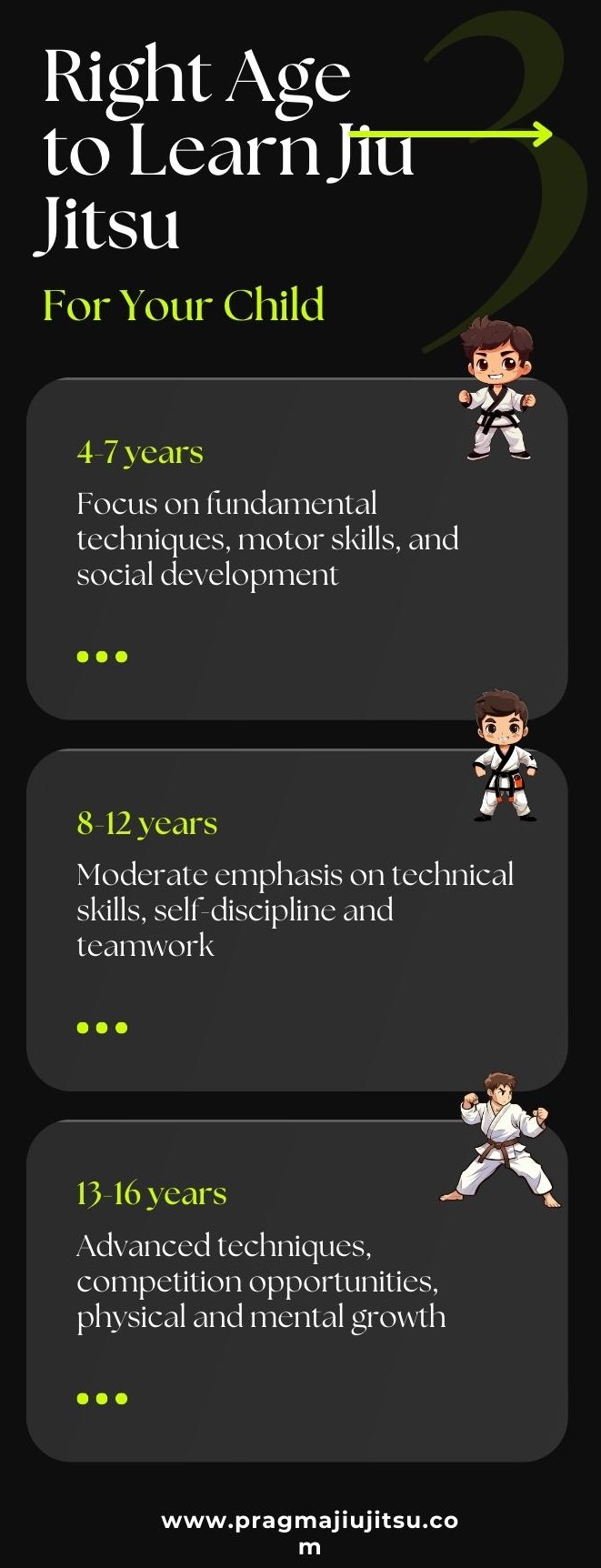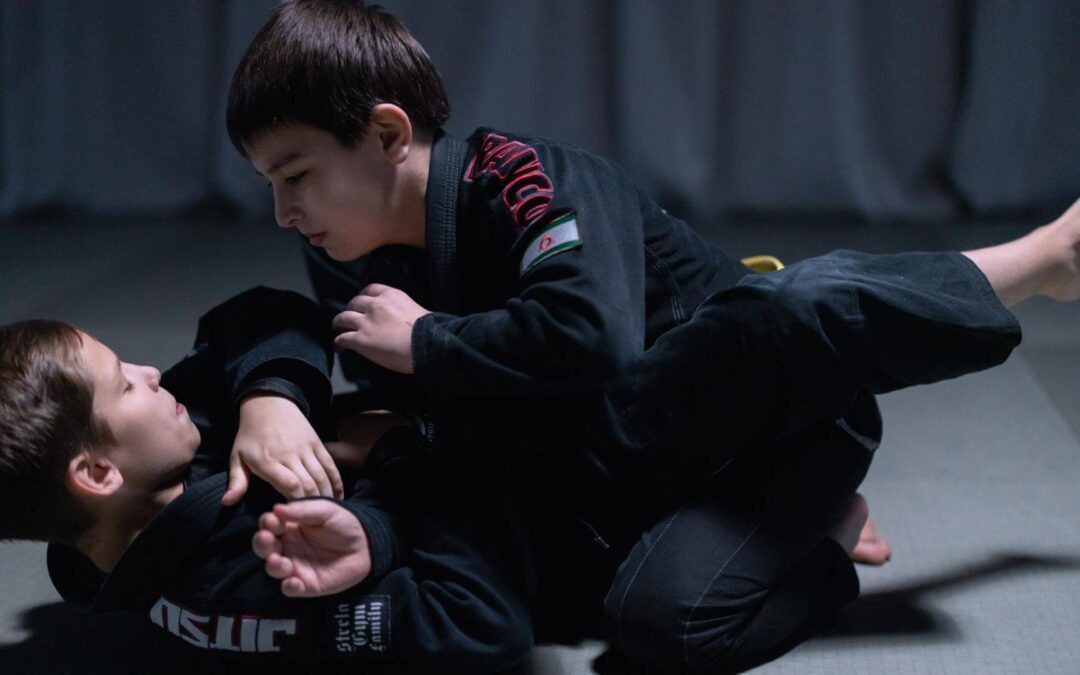Are you wondering what age to start kids jiu jitsu classes? Maybe you’ve seen or are searching for some kids Jiu Jitsu classes in Hutto for better physical and emotional upbringing for your little one but are not sure about the right age? As a parent, you want to ensure that your child enters the world of martial arts at an appropriate age for their development. Early jiu jitsu training for kids provides various physical, mental, and social benefits, but timing is crucial.
Generally, children can begin learning the basics of Brazilian Jiu-Jitsu as early as 4 years old when they have sufficient motor skills and coordination. In this guide, we’ll explore the key factors to consider when finding jiu jitsu for kids classes that suit your child’s needs and align with their growth.
Understanding the Basics of Jiu Jitsu for Children
Brazilian Jiu-Jitsu is a grappling form of martial art that uses ground-based techniques. Children learning BJJ acquire self-defense skills without striking and use wrestling techniques to manage dangerous situations, which is instrumental in establishing dominant positions or applying submissions if necessary. BJJ emphasizes using technique, timing, and leverage over strength and power, which aligns with Master Helio Gracie’s teachings and ensures that it adapts well to children’s capabilities.
Jiu-Jitsu doesn’t depend on strength and power but rather technique, timing, and leverage, making it ideal for children who are still developing physically.
Since jiu jitsu for children heavily emphasizes self-defense, it is popular among parents searching for an ideal martial arts program for children. Kids Jiu Jitsu classes in Hutto provide a nurturing environment for learning and practicing this self-defense-focused martial art, effectively instilling values such as respect, discipline, and perseverance in young students.
Let’s take a closer look at some of the fundamentals of children’s jiu jitsu:
- Ground-based Techniques: BJJ primarily focuses on ground-based techniques, such as joint locks and chokes, to neutralize opponents.
- Physical Control: Children learn various ways to control their opponents on the ground without having to rely on strikes or brute force.
- Defense over Offense: Jiu jitsu for children emphasizes self-defense skills and techniques rather than offensive moves.
To further illustrate the core principles of children’s jiu jitsu training, let’s examine some commonly taught techniques:
| Technique | Description |
| Guard | A fundamental ground position in BJJ is where the practitioner, lying on their back, uses their legs to control their opponent. |
| Mount | A dominant top position where one person sits on their opponent’s chest allows for effective control and submission options. |
| Armbar | A joint lock submission technique is applied to the elbow, forcing the opponent to tap out due to excessive pressure and discomfort. |
| Rear Naked Choke | A choking technique is applied from behind the opponent, using the arms to constrict the airway and induce submission. |
Jiu-jitsu for children is designed to meet the physical capabilities, interests, and safety needs of young students. This ensures that your child’s introduction to BJJ is not only an enjoyable experience but also a valuable one in terms of personal growth and development.
Reasons to Start Jiu Jitsu Training at a Young Age
Starting kids Jiu Jitsu classes in Hutto presents numerous physical, mental, and social benefits for your little one. The jiu jitsu age range extends from very young to well into adulthood, which provides ample opportunities for growth and development regardless of the starting point. Here, we explore the advantages of beginning a martial art during childhood.
- Physical fitness and coordination: Jiu jitsu for youth offers an excellent platform to build fitness levels, motor skills, and overall body coordination, which translates to a healthy and active lifestyle later in life.
- Focus and self-discipline: The art of jiu jitsu demands concentration and discipline, fostering essential skills that extend beyond the dojo into schoolwork and everyday life.
- Boosting self-esteem: As children progress through the rankings and master new techniques, they experience a surge in self-confidence derived from their achievements.
- Social skills: Participating in group activities such as jiu jitsu classes promotes teamwork, cooperation, and relationship-building, all crucial components of youthful development.
These benefits highlight the compelling reasons to begin jiu jitsu training early, allowing children to reap the rewards from a young age.
| Benefits | Physical | Mental | Social |
| Skills developed |
Fitness Coordination |
Focus Self-discipline |
Teamwork Cooperation |
| Long-term outcomes | Healthy lifestyle | Academic success | Strong relationships |
With its comprehensive array of physical, mental, and social benefits, starting jiu jitsu at a young age provides an enriching and rewarding experience for any child. By introducing them to the martial art early on, you are laying the foundation for a well-rounded, confident, and healthy individual.
Finding the Right Jiu Jitsu Program for Your Child
When selecting a Jiu-Jitsu program for your child, it is crucial to seek out age-specific jiu jitsu programs that boast entertaining, skill-enhancing activities and instill respect and discipline. Programs led by qualified instructors with verifiable credentials and the capability to teach children effectively are optimal. Moreover, the importance of training environments that uphold stringent health and safety criteria cannot be overstated for the child’s welfare and positive experiences.
- Age-appropriate classes and curriculum
- Instructors’ qualifications and experience in children’s martial arts
- Safe and clean training environments
“In teaching children, we must be attentive to their unique needs and growth. This entails finding a Jiu Jitsu program that aligns with their developmental stage and interests.”
It can be beneficial to visit multiple schools and observe kids Jiu Jitsu classes in Hutto before making your final decision. Consult with the instructors and other parents to better understand the expectations and dynamics of the program. With the right blend of age-specific instruction and enthusiastic, competent instructors, your child can flourish in their Jiu Jitsu journey.
The Role of Physical and Emotional Development in Starting Jiu Jitsu
Introducing a child to Jiu Jitsu should align with their natural growth pace, ensuring that the physical activities within the class are tailored to aid rather than hinder their development. Doing so often involves categorizing classes by age, such as 5-7 years with 30-minute sessions, 8-12 years with sessions up to 60 minutes, and specialized groups for teenagers up to 16.
rather than hinder their development. Doing so often involves categorizing classes by age, such as 5-7 years with 30-minute sessions, 8-12 years with sessions up to 60 minutes, and specialized groups for teenagers up to 16.
Understanding developmental stages is critical, as premature involvement may result in sports aversion, while delayed participation might miss key formative lessons. It is crucial to acknowledge the unique needs of children in the context of physical development in martial arts and athletic education.
Acknowledging the significance of emotional development in Jiu Jitsu is fundamental to ensuring a positive experience for the child. Martial arts training presents an opportunity for children to develop essential emotional skills such as emotional intelligence, self-awareness, and self-regulation.
These critical life skills will bolster their interpersonal relationships and emotional well-being, further contributing to their overall growth and martial arts training.
Jiu-Jitsu does not simply offer physical benefits but also encompasses a range of emotional and mental developments that will serve children well as they navigate through life’s various challenges.
Some factors to consider when aligning Jiu Jitsu training with a child’s developmental stage include:
- Physical readiness: Ensuring the child can engage safely in physical activities and exercises suitable for their age and abilities.
- Mental maturity: Ensuring the child understands the critical values within the sport, such as respect, discipline, and dedication.
- Emotional resilience: Building the child’s capacity to handle challenges, setbacks, and frustrations inherent in martial arts training.
Children’s physical and emotional development should be carefully considered in any martial arts program, making sure young participants feel safe and comfortable. This balance ensures that children can enjoy kids Jiu Jitsu classes in Hutto while growing and benefiting from the discipline’s myriad virtues.
| Age Group | Session Duration | Key Developments |
| 5-7 years | 30 minutes | Basic techniques, motor skills, confidence |
| 8-12 years | 45-60 minutes | Refining techniques, strategy, discipline |
| Teenagers (13-16 years) | 60 minutes | Advanced techniques, leadership, resilience |
By paying careful attention to the physical and emotional development factors relevant to Jiu Jitsu training, children are presented with an opportunity to grow holistically. Integrating martial arts education into a child’s life greatly contributes to their long-term development and personal success.
Jiu Jitsu Belt System and Setting Achievable Goals for Kids
The jiu jitsu belt system for kids plays a vital role in setting achievable goals and marking progress within the sport. This organized system encourages kids to work hard, stay motivated, and continuously develop their skills in martial arts. Moreover, it fosters discipline while setting the stage for further achievements and personal growth.
The Importance of Gradual Progression in Kids’ Martial Arts
Gradual progression in martial arts is a crucial aspect in ensuring that each kid experiences genuine improvements in skill, knowledge, and self-confidence. By incorporating various ranks, the jiu jitsu belt system for kids caters to their developing abilities and aligns their personal milestones with age-appropriate expectations and training programs.
Emphasizing the importance of the learning process over instant success allows kids to develop a resilient mindset and maintain focus on their martial arts journey while appreciating the hard work and dedication required to achieve their goals.
Recognizing Milestones: Celebrating Your Child’s Jiu Jitsu Achievements
One of the most rewarding aspects of the kids jiu jitsu belt system is the opportunity to acknowledge and celebrate key milestones as kids progress through the ranks. Whether it’s mastering a new technique or earning a belt promotion, these moments serve as significant motivational and developmental landmarks for children.
By recognizing and celebrating achievements, both big and small, kids are encouraged to continue learning and growing within the sport. This acts as a powerful tool in maintaining interest and commitment, all while reinforcing a sense of accomplishment and self-esteem.
How Belt Promotions Foster Motivation and Discipline
“The journey of a thousand miles begins with a single step.” – Lao Tzu
The jiu jitsu belt system represents a visible reminder of a child’s progress and achievements. With each promotion, kids are motivated to strive for higher goals and maintain discipline in their training. This has the potential to create a lasting positive impact on their martial arts journey, resulting in long-term dedication and development.
Consistent promotions, particularly in the formative years of a child’s jiu jitsu experience, not only encourage hard work but also help establish a strong foundation for their martial arts education. This serves as both a symbol of their commitment and a reminder of the progress they have made thus far.
Making the Decision: When Is Your Child Ready for Jiu Jitsu?
Determining the right moment for a child to get kids Jiu Jitsu classes in Hutto requires considering both physical and psychological readiness. While 5 years is often suggested as an ideal starting age, individual variance can influence the appropriate timing. Reflect on your child’s development and make a decision that accommodates their unique growth.
Additional factors such as the availability of age-suitable classes, the desire of the child to participate, and the capacity of a gym to offer classes in the morning and afternoon must be assessed. Research local martial arts schools, inquire about their programs and find the best match for your child’s needs and interests.
If necessary, mixed-age class structures with adequate supervision and instruction can bridge the gap between the optimal scenario and available resources to deliver beneficial learning experiences tailored to a diverse age range. Speak with instructors about their approach to managing various age groups and skill levels in their classes, ensuring they can provide the best atmosphere and learning experience for your child.

